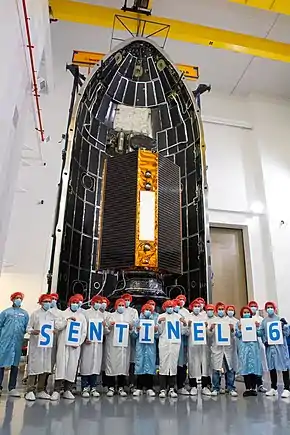Sentinel-6 Michael Freilich
The Sentinel-6 Michael Freilich satellite is a radar altimeter satellite which was developed by European Space Agency (ESA) in the context of the European Copernicus Programme led by the European Commission, the European Organisation for the Exploitation of Meteorological Satellites (EUMETSAT), NASA, and the National Oceanic and Atmospheric Administration (NOAA), with funding support from the European Commission and technical support from France's National Centre for Space Studies (CNES, Centre national d'études spatiales).[1]
.jpg.webp) Illustration of the Sentinel-6 Michael Freilich spacecraft in orbit above Earth with its deployable solar panels extended | |
| Names | Sentinel-6A Jason-CS A |
|---|---|
| Mission type | Oceanography mission |
| Operator | EUMETSAT / NASA |
| COSPAR ID | 2020-086A |
| SATCAT no. | 46984 |
| Website | www |
| Mission duration | 5.5 years (planned) 74 days and 12 hours (in progress) |
| Spacecraft properties | |
| Bus | Sentinel-6 |
| Manufacturer | Airbus Defence and Space |
| Launch mass | 1192 kg |
| Dimensions | 5.13 x 4.17 x 2.34 metres |
| Power | 891 watts |
| Start of mission | |
| Launch date | 21 November 2020, 17:17:08 UTC |
| Rocket | Falcon 9 Block 5 |
| Launch site | Vandeberg, SLC-4E |
| Contractor | SpaceX |
| Orbital parameters | |
| Reference system | Geocentric orbit |
| Regime | Low Earth orbit |
| Altitude | 1,336 km |
| Inclination | 66.0° |
| Repeat interval | 10 days |
| Instruments | |
| |
 Logo of the Sentinel-6 programme | |
Spacecraft

The Sentinel-6 program includes two identical satellites, to be launched five years apart, Sentinel-6 Michael Freilich, which launched on 21 November 2020[2] and Sentinel-6B, which will launch in 2025.[3] These satellites will measure sea level change from space, which have been measured without interruption since 1992.[4][5]
Formerly called Sentinel-6A and Jason-CS A (Jason Continuity of Service-A) it was renamed in honor of the former director of NASA Earth Science Division, Dr Michael Freilich, who was instrumental in advancing space-based ocean measurements. It follows the most recent U.S.-European sea level observation satellite, Jason-3, which launched in 2016, and is currently providing high-precision and timely observations of the topography of the global ocean.[6]
Context
Since the launch of TOPEX/Poseidon on 10 August 1992, high-precision satellite altimeters have been essential to monitor how the ocean stores and redistributes heat, water, and carbon in the climate system. The two satellites, Sentinel-6 Michael Freilich and Sentinel-6B, will extend this legacy through to at least 2030 which will provide a nearly forty-year record of sea level rise as well as changes in ocean currents.[3][7]
Partnership
The Sentinel-6 mission is part of the Copernicus programme initiative, the main objective of the Sentinel-6 mission is to measure sea surface topography with high accuracy and reliability to support ocean forecasting systems, environmental monitoring and climate monitoring.[8]
The mission definition is driven by the need for continuity in provision of TOPEX/Poseidon mission and Jason satellite series (Jason-1, OSTM/Jason-2, and Jason-3) with improvements in instrument performance and coverage.[9] ESA, NASA, and EUMETSAT will provide mission management and system engineering support. EUMETSAT and NASA will be responsible for long-term archives of altimetry data products. All partners will be involved with the selection of science investigators.[9]
Responsibilities of partners
- ESA has responsibility for the development of the first satellite and the ground prototype processors and for procurement of the second satellite on behalf of EUMETSAT and the European Commission;
- ESA has responsibility for launch and early operations phase (LEOP) of both satellites;
- ESA will support flight operations performed by EUMETSAT;
- EUMETSAT has responsibility for ground segment development and coordination at system level, including for operations preparation;
- EUMETSAT will have responsibility for operations of the two satellites after LEOP performed by ESA;
- EUMETSAT will have responsibility for operations of the European part of the ground segment, including processing of altimeter data and delivery of product services to European users;
- NASA has responsibility for the development and delivery of the U.S. payload instruments, the microwave radiometer and the GNSS radio occultation receiver;
- NASA provides launch services for both satellites;
- NASA provides ground segment development support and will contribute to operations and data processing on the U.S. side, including processing of GNSS radio occultation data;
- NASA and NOAA will share responsibility for the distribution of products to research and operational users in the U.S.;
- NOAA provides a U.S. ground station for tracking and command of the satellite and data downlinks;
- CNES has responsibility for processing higher-level products (L2B, L3) and for providing precise orbit determination and support for Doris and altimeter operations.[10]
Instruments
- Radar altimeter, developed by ESA, based on the Sentinel-3 SARL instrument, but with a design adopted to allow the interleaved mode combining the synthetic aperture radar (SAR) mode and the low resolution mode (LRM) based on pulse-limited altimeter.
- Advanced Microwave Radiometer (AMR-C) provided by NASA
- Global Navigation Satellite System (GNSS) Precise Orbit Determination (POD) receiver, developed by ESA and derived from the GNSS Receiver on Sentinel-3
- Doppler Orbitography and Radiopositioning Integrated by Satellite (DORIS Receiver), identical to the one used on Jason-3 and Sentinel-3
- Laser Reflector Array (LRA), used for satellite laser ranging, identical to the one used on Jason-3, provided by NASA
- GNSS Radio Occultation (GNSS-RO) based on a Tri-G receiver, provided by NASA[11]
References
- Greicius, Tony (19 November 2020). "Sentinel-6 Michael Freilich Satellite Prepared for Launch". NASA. Retrieved 21 November 2020.
 This article incorporates text from this source, which is in the public domain.
This article incorporates text from this source, which is in the public domain. - Howell, Elizabeth (20 November 2020). "SpaceX will launch the Sentinel-6 ocean-mapping satellite Saturday". Space.com. Retrieved 21 November 2020.
- "Jason-CS (Sentinel 6) Summary". sealevel.jpl.nasa.gov. NASA. August 2020. Retrieved 2 November 2020.
 This article incorporates text from this source, which is in the public domain.
This article incorporates text from this source, which is in the public domain. - "NOAA - Satellite and Information Services". nesdis.noaa.gov. NOAA. Retrieved 29 October 2019.
 This article incorporates text from this source, which is in the public domain.
This article incorporates text from this source, which is in the public domain. - B, Mark (8 September 2020). "NASA Sentinel 6 Michael Freilich to Launch in November". Science Times.
- "NASA TV to Air Sentinel-6 Michael Freilich Launch, Prelaunch Activities". NASA. 13 November 2020. Retrieved 22 November 2020.
 This article incorporates text from this source, which is in the public domain.
This article incorporates text from this source, which is in the public domain. - "Upcoming Satellite Mission will Improve Hurricane Forecasts and Climate Science, NOAA Expert Says; NOAA National Environmental Satellite, Data, and Information Service (NESDIS)". nesdis.noaa.gov. NOAA.
 This article incorporates text from this source, which is in the public domain.
This article incorporates text from this source, which is in the public domain. - "Copernicus Sentinel-6: Testing Complete for New International Ocean Satellite". SciTechDaily. 15 June 2020.
- "Sentinel-6 Overview". sentinel.esa.int. ESA. Retrieved 29 October 2019.
- "Sentinel-6". eumetsat.int. EUMETSAT. Retrieved 21 November 2020.
- "Sentinel-6 | EUMETSAT Website". eumetsat.int. Retrieved 21 November 2020.

